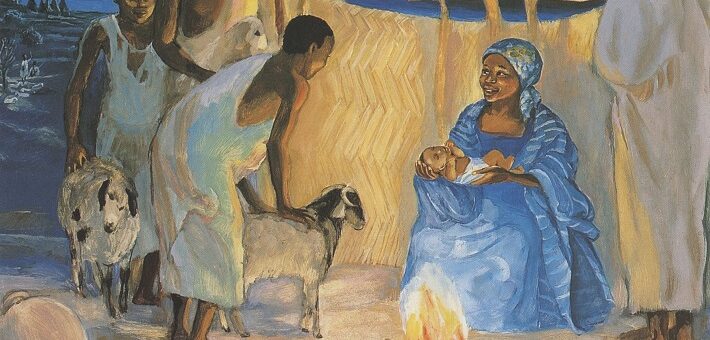Commentary on Luke 2:8-20
Christmas may be one of the most difficult days on which to preach during the entire liturgical year.
It is not that the texts are themselves complicated; it is that everyone has heard the Lukan Christmas story. Those who regularly attend worship will be familiar with the texts leading up to this pericope, while those whose only exposure to Scripture is Christmas may not have the context of the story or know how the gospel continues. So, preachers could consider themselves between a rock and a hard place—how not to sound repetitive to the regular worshipers while proclaiming the entirety of the gospel to those who only hear Scripture annually.
One reason that the preacher should not succumb to such anxiety is to remember that the sermon is not the only time the gospel is proclaimed during the Christmas liturgy. The treasury of Christmas hymns with recognizable tunes are full of poetic words that assist in proclaiming the gospel. The prayers—Prayer of the Day, Intercessions, Eucharistic Prayer—connect to the themes of the ‘with-ness’ of God in the humblest of circumstances. This repetition is important, and St. Ambrose (original author of the Christmas hymn “Savior of the Nations, Come”) reminds us that repetition is central to the Christmas story:
See how divine care adds faith. An angel tells Mary [see NL316: Luke 1:26-49], an angel tells Joseph [see Matthew 1:20 and following], an angel tells the shepherds. It does not suffice that a messenger is sent once. For every word stands with two or three witnesses.1
So, as the angels said to the shepherds, “Do not be afraid!”
In continuing the theme of the infancy narrative, God delivers a message through angels to the lowly. While current culture views the shepherds as quaint and hardworking, the ancient near east would have seem them as outcasts. Here again Luke provides a coupling of opposites (like in the Magnificat): the Savior and Messiah is revealed to those who would never be allowed to come in proximity to royalty. Also, the shepherding image from the Psalms directly connects them to the Davidic line of Jesus.
What the angel proclaims is the “good news”—the evangelion—the very gospel that the preacher proclaims on this day. Yet, the angel does not restrict this gospel to the shepherds. Rather, it is for “all the people.” The “with-ness” that God reveals to Mary and the shepherds is the “with-ness” for all creation.
As if one angel was not enough, an entire gathering appears and proclaims God’s glory. The Gloria in excelsis is the shortest of Luke’s canticles, which is later expanded in the fourth century and included in Morning Prayer, and then later is added to the Eucharistic liturgy. This short canticle also contains couplets to describe the relationship between the divine and the human: glory and peace, highest heaven and earth, God and among people (NRSV alternate translation).
The shepherds do not question what they saw and heard, and go to Bethlehem to experience what they were told. The “with-ness” proclaimed to them leads them to witness God’s full revelation in the birth of Jesus.
The angel’s message to the shepherds is that the birth happens “today”—it is happening right now! As in NL316, here again Luke is specific about the when and where, highlighting that these are concrete events that have importance in the lives of real people. The church has continued to emphasize “today” in the historic Prayers of the Day (Collects), which speaks to this specific day as the one in which God reveals God’s self. Our annual festival of Jesus’ birth is not something that remains in the past upon which we can fondly think about, nor is it something that we pull into the present as some sort of reenactment. Rather, our remembering (anamnesis in Greek) is about a continuous reality, one that did not stop over 2000 years ago but continues to be ongoing. As the final stanza of “O Little Town of Bethlehem” states, “O holy child of Bethlehem … be born in us today … abide with us, our Lord Immanuel.”
The extra-canonical Protoevangelium of James fills in some of the missing details and has been the source for artistic depictions of the first Christmas. Early Christians were told that the manger was a cave (18:1), which further highlights the humble and dirty circumstances surrounding Jesus’ birth. This text also introduces the character of Salome the midwife, whose exclamation at the sight of the birth in words reminiscent of both Mary and later Simeon (19:2). Salome was not permitted to see the birth take place but instead was overshadowed with a cloud, using language reminiscent of God’s revelation at the Transfiguration (see Luke 9:34-35). Luke also uses overshadowed to describe God’s power to Mary at the Annunciation (see NL316).
The shepherds, just like the angel and Elizabeth before them, reveal to Mary what God has promised. They leave changed by what they had witnessed, and thus become witnesses for others. The “with-ness” that God has revealed pushes the shepherds to proclaim this “with-ness” to all they encounter. Their actions of “glorifying and praising God” mirror the glory and praise that had been proclaimed to them by the angels. The angels have completed their task—three times as St. Ambrose wrote—and have returned from where they came. They are no longer needed as heavenly messengers, for the gospel has become incarnate in Christ Jesus, the good news enfleshed and with us in our own witnesses to the amazing work of God.
Notes
- Saint Ambrose, Exposition of the Holy Gospel According to Saint Luke with Fragments on the Prophecy of Isaias, trans. Theodosia Tomkinson, 2nd edition (Etna, Calif: Center for Traditionalist, 1998), 57.
PRAYER OF THE DAY
Infant holy,
We praise God for this day when we celebrate your miraculous birth! Transform us as you were transformed so that we may perfectly love you with our whole being, for the sake of the one who came humble and powerless, and became glory and power, Jesus Christ. Amen.
HYMNS
O come, all ye faithful ELW 283, H82 83, UMH 234, NCH 135
Angels from the realms of glory ELW 275, H82 93, NCH 126, UMH 220
Go tell it on the mountain ELW 229, H82 99, NCH 154, UMH 251, TFF 52
CHORAL
While shepherds watched, Hugo Jungst


December 25, 2020